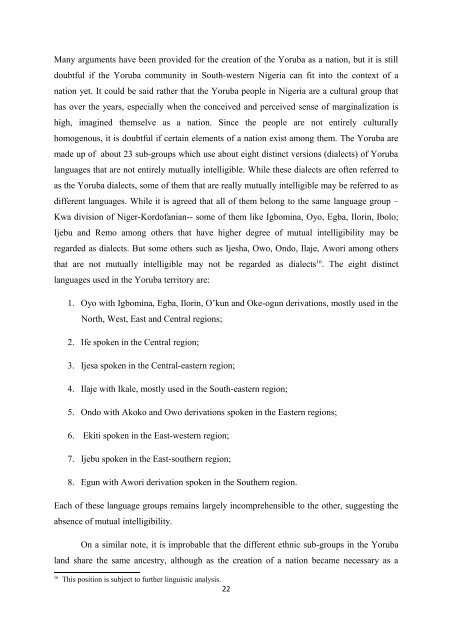The Yoruba Nationalist Movements, Ethnic Politics and Violence: A ...
The Yoruba Nationalist Movements, Ethnic Politics and Violence: A ...
The Yoruba Nationalist Movements, Ethnic Politics and Violence: A ...
You also want an ePaper? Increase the reach of your titles
YUMPU automatically turns print PDFs into web optimized ePapers that Google loves.
Many arguments have been provided for the creation of the <strong>Yoruba</strong> as a nation, but it is still<br />
doubtful if the <strong>Yoruba</strong> community in South-western Nigeria can fit into the context of a<br />
nation yet. It could be said rather that the <strong>Yoruba</strong> people in Nigeria are a cultural group that<br />
has over the years, especially when the conceived <strong>and</strong> perceived sense of marginalization is<br />
high, imagined themselve as a nation. Since the people are not entirely culturally<br />
homogenous, it is doubtful if certain elements of a nation exist among them. <strong>The</strong> <strong>Yoruba</strong> are<br />
made up of about 23 sub-groups which use about eight distinct versions (dialects) of <strong>Yoruba</strong><br />
languages that are not entirely mutually intelligible. While these dialects are often referred to<br />
as the <strong>Yoruba</strong> dialects, some of them that are really mutually intelligible may be referred to as<br />
different languages. While it is agreed that all of them belong to the same language group –<br />
Kwa division of Niger-Kordofanian-- some of them like Igbomina, Oyo, Egba, Ilorin, Ibolo;<br />
Ijebu <strong>and</strong> Remo among others that have higher degree of mutual intelligibility may be<br />
regarded as dialects. But some others such as Ijesha, Owo, Ondo, Ilaje, Awori among others<br />
that are not mutually intelligible may not be regarded as dialects 16 . <strong>The</strong> eight distinct<br />
languages used in the <strong>Yoruba</strong> territory are:<br />
1. Oyo with Igbomina, Egba, Ilorin, O’kun <strong>and</strong> Oke-ogun derivations, mostly used in the<br />
North, West, East <strong>and</strong> Central regions;<br />
2. Ife spoken in the Central region;<br />
3. Ijesa spoken in the Central-eastern region;<br />
4. Ilaje with Ikale, mostly used in the South-eastern region;<br />
5. Ondo with Akoko <strong>and</strong> Owo derivations spoken in the Eastern regions;<br />
6. Ekiti spoken in the East-western region;<br />
7. Ijebu spoken in the East-southern region;<br />
8. Egun with Awori derivation spoken in the Southern region.<br />
Each of these language groups remains largely incomprehensible to the other, suggesting the<br />
absence of mutual intelligibility.<br />
On a similar note, it is improbable that the different ethnic sub-groups in the <strong>Yoruba</strong><br />
l<strong>and</strong> share the same ancestry, although as the creation of a nation became necessary as a<br />
16<br />
This position is subject to further linguistic analysis.<br />
22

















